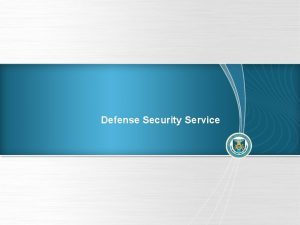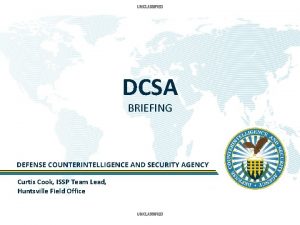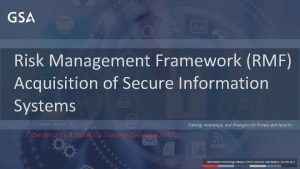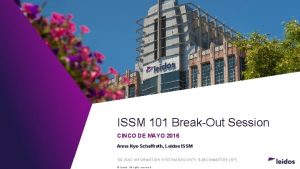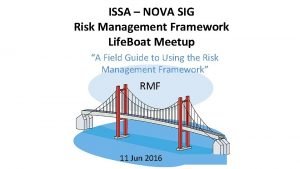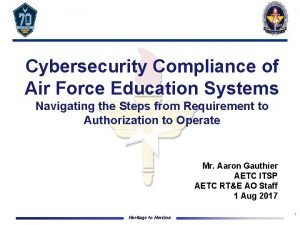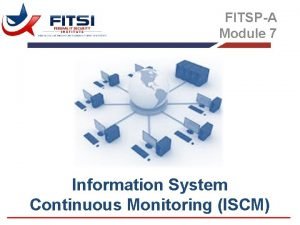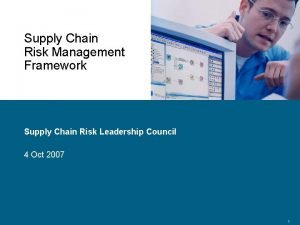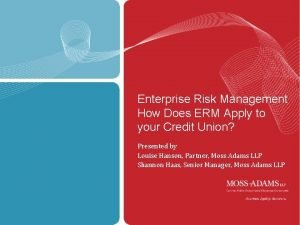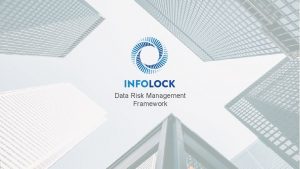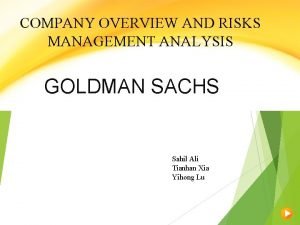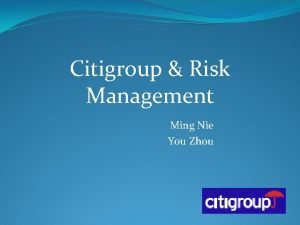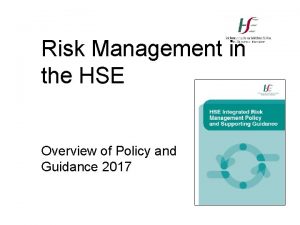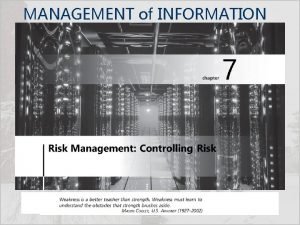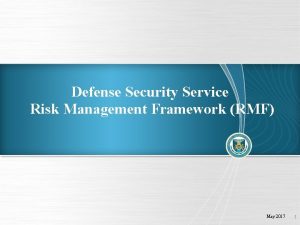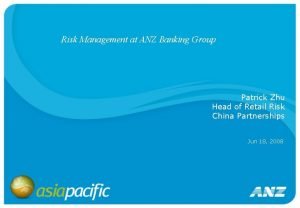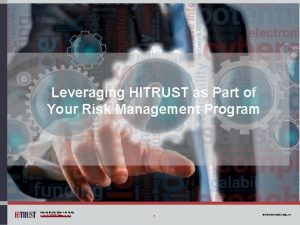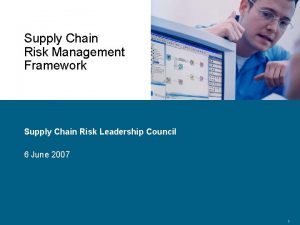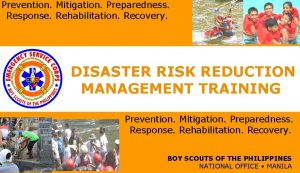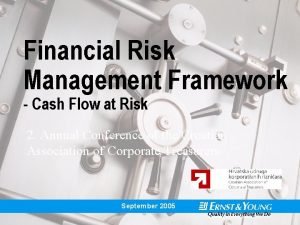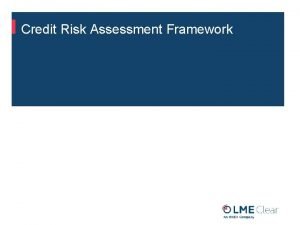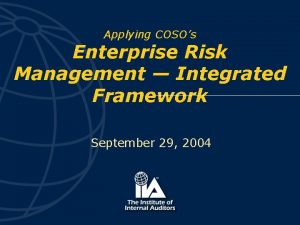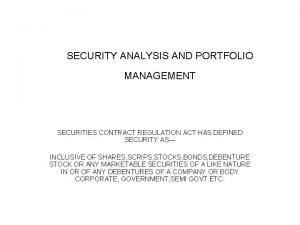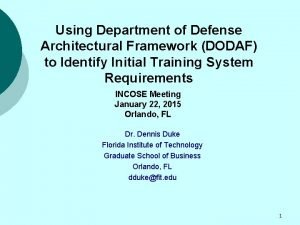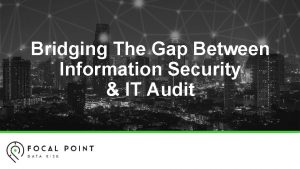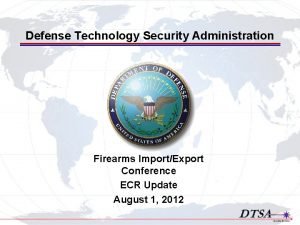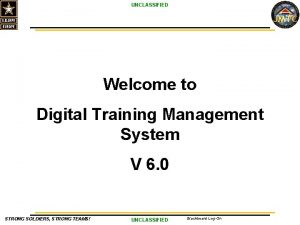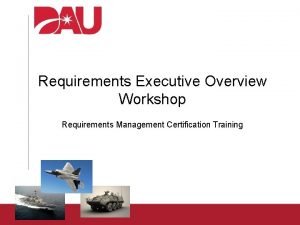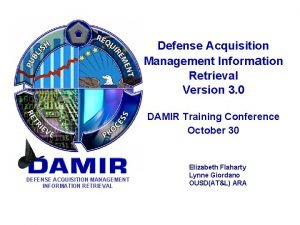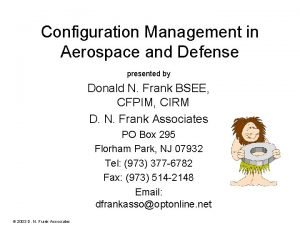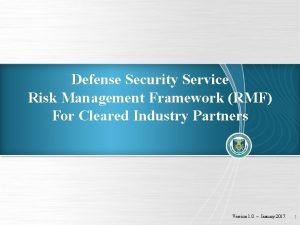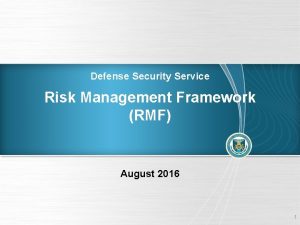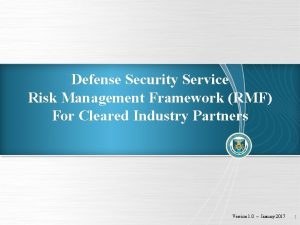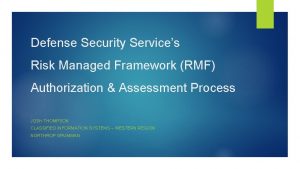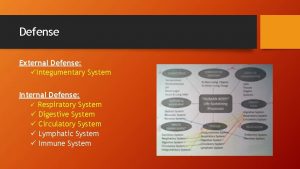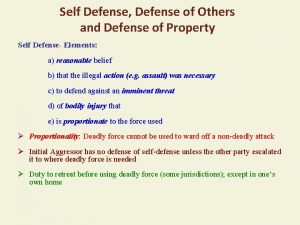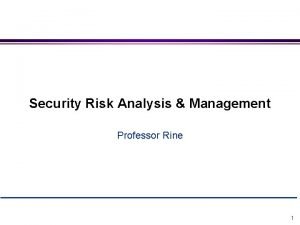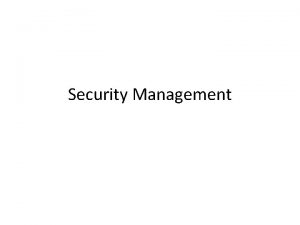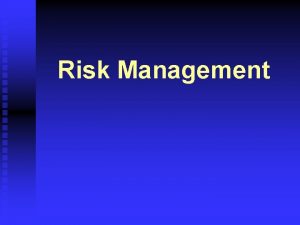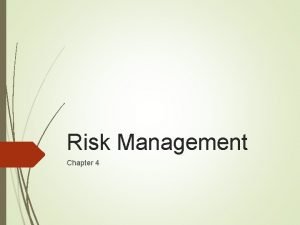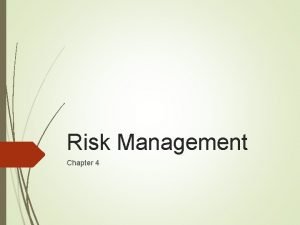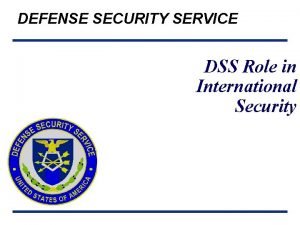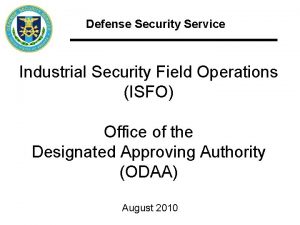Defense Security Service Risk Management Framework RMF May







































- Slides: 39

Defense Security Service Risk Management Framework (RMF) May 2017 1

Goals of the Presentation • • • Review terminology/resources for RMF Set expectations for completing documentation Provide examples for discussion Address Authorization requests via OBMS Discuss Security Controls Assessor (SCA) Visit to the facility -2 -

RMF Basics Ø What is Risk Management Framework (RMF)? o A unified information security framework for the entire federal government that replaces legacy Certification and Accreditation (C&A) processes applied to information systems (ISs). o A key component of an organization’s information security program used in the overall management of organizational risk. Ø When will RMF replace C&A (Phased Implementation)? o RMF has already replaced C&A for Stand-Alone systems as of October 3, 2016. Multi-User Standalones (MUSA) and Single-User Standalones (SUSA) were required to execute the RMF process for any expiring C&A accreditations and new submittals. o The Transition date for Local Area Networks (LAN) and Wide Area Networks (WAN) is tentatively set for January 1, 2018. (You can submit RMF plans prior to the start date) -3 -

Here is the way some people see things NIST SP-800 -53 r 4 DOD 5220. 22 -M (NISPOM) DISA STIGs SCAP Compliance Checker DSS In Transition NIST SP-800 -37 NIST SP-800 -30 System Assessment Report (SAR) Terminology/Resources NIST SP 800 -60 Risk Assessment Report (RAR) CNSSI-1253 SSP Appendices SSP Continuous Monitoring DAAPM NIST SP 800 -61 NIST SP 800 -53 A www. dss. mil/rmf CDSE Training on RMF NIST SP-800 -137 ISSM Certification Statement -4 -

RMF Policy References Local Area Network, Wide Area Network or Interconnected System between August 1, 2016 – 28 February 2017 -5 -

Planning Guidance/Resources NISPOM- DOD 5220. 22 -M, Dated February 2006 (with change 2 dated May 18, 2016) Basic starting point for cleared contractors to implement RMF (NISPOM 8 -100. d) DAAPM- DSS Assessment and Authorization Process Manual, Dated August 24, 2016 Basic guidance for requesting the authorization of an information system for classified Government work. CDSE RMF Training- There are 7 courses that ISSMs are required to complete to get an Overall understanding of RMF (see “ISSM Required Online Training” in the DAAPM). www. dss. mil/rmf- One stop website for many tools and templates needed for RMF NIST SP-800 -37 (rev 1) - Guide for Applying the Risk Management Framework to Federal Information Systems, dated February 2010 (with June 2014 updates) NIST SP-800 -30 (rev 1)- Guide for Conducting Risk Assessments, dated September 2012 NIST SP 800 -60 (vol 1 -2)- Guide for mapping information to categories, Dated August 2008 NIST SP-800 -53 (rev 4)- Security and Privacy Controls for Federal Information Systems and Organizations, Dated April 2013 (with Jan 2015 updates) NIST SP 800 -61 (rev 2)- Computer Security Incident Handling Guide, Dated August 2012 CNSSI-1253 Security Categorization and Control Selection for National Security Systems, Dated March 27, 2014 -6 -

Security Controls and Continuous Monitoring The RMF process will manage risk more effectively through the introduction of security controls and continuous monitoring of those controls. Purpose of Security Controls and Continuous Monitoring üAssess security control effectiveness for an IS üDocument changes to the IS or its environment of operation üConduct security impact analyses of associated changes üReport the security status of an IS Benefits of Security Controls and Continuous Monitoring üFacilitate more efficient enterprise management of cybersecurity üIncrease security in the system development and acquisition processes üEnsure compliance with national standards and reporting requirements National Industrial Security Program Operating Manual (NISPOM) Resources to assist in the RMF Process Many additional resources can be found on the NIST website (www. nist. gov) NIST SP 800 -37: Guide for Applying the Risk Management Framework to Federal Information Systems NIST SP 800 -137: Information Security Continuous Monitoring (ISCM) for Federal Information Systems and Organizations NIST SP 800 -53: Security and Privacy Controls for Federal Information Systems and Organizations NIST SP 800 -53 A: Assessing Security and Privacy Controls in Federal Information Systems and Organizations: Building Effective Assessment Plans Committee on National Security Systems Instruction (CNSSI) 1253: Security Categorization and Control Selection for National Security Systems -7 -

RMF Process Stakeholders – New Terminology Many RMF stakeholder titles have been revised in the transition from C&A. The following table outlines former terms in the C&A process as well as the corresponding new terms in the RMF process. Both sets of terms will continue to be used during the transition to RMF. Old Term in the C&A Process New Term in the RMF Process Designated Approving Authority (DAA) Authorizing Official (AO) Regional Designated Approving Authority (RDAA) Regional Authorizing Official (RAO) Office of the Designated Approving Authority (ODAA) NISP Authorization Office (NAO) Information Systems Security Professional (ISSP) ISSP/Security Control Assessor (SCA) Customer, Government Contracting Activity (GCA) Information Owner (IO) Contractor Information System Owner (ISO) *Information Systems Security Manager (ISSM) ISSM *Information Systems Security Officer (ISSO) ISSO *Titles will remain the same in RMF. -8 -

Connecting the Dots – What is Changing? What is staying the same? Process C&A RMF ODAA Business Management System (OBMS) Same System Security Plan (SSP) Template C&A Template RMF Template Categorization Basic, Med, High Low, Mod, High PLs Accessibility Certification Statement Same Risk Acknowledgement/Tailoring-out Risk Acknowledged Tailored-Out/Risk Acknowledgement MOU MOU/ISA Standing-Up Like System Self. Certification Type Authorization Controls NISPOM Refs NIST Controls Approval to Process Accreditation Authorization -9 -

Connecting the Dots – What is Changing? What is staying the same? Process C&A RMF OBMS File Designation Submit Artifacts within OBMS ü SSP ü Certification Statement ü Profile ü SSP ü Certification Statement ü Risk Assessment Report ü POA&M ü SSP Supporting Artifacts (appendices) SSP Issues Related to Authorization Comments Form Accreditation Letter Security Package Submission and Certification Statement IS Profile Other Comments form used to concur with categorization/controls Terms & Conditions in Authorization Letter - 10 -

RMF Process Walk Through: Introduction Starting Point 1. CATEGORIZE Information System ISSM conducts risk assessment to determine system categorization (confidentiality, integrity, and availability). 6. MONITOR Security Controls ISSM continuously tracks and reports IS changes to the ISSP IAW the Continuous Monitoring Plan/Strategy. 5. AUTHORIZE Information System AO determines risk. If acceptable, AO formally authorizes system to operate. NISP Assessment & Authorization Life Cycle 4. ASSESS 2. SELECT Security Controls ISSM selects security controls and applies tailoring and supplemental controls as needed based on risk assessment. ISSP reviews SSP and provides concurrence. 3. IMPLEMENT Security Controls ISSM implements security controls selected for the IS. Security Controls ISSM conducts self-assessment and updates the SSP to reflect the actual state of the IS. ISSP reviews submitted SSP and assesses the IS. - 11 -

CDSE Training Courses Ø RMF Courses q. Introduction to RMF (CS 124. 16) q. Continuous Monitoring (CS 200. 16) q. Categorization of the System (CS 102. 16) q. Selecting Security Controls (CS 103. 16) q. Implementing Security Controls (CS 104. 16) q. Assessing Security Controls (CS 105. 16) q. Authorizing Systems (CS 106. 16) q. Monitoring Security Controls (CS 107. 16) - 12 -

RMF Process Walk Through STEP 1: Categorize the IS ISSM Actions: ü Categorize the Information System (IS) based on the impact due to a loss of Confidentiality, Integrity, and Availability of the information that will be processed. (Note: The DSS SSP template is based on a Moderate Confidentiality, Low Integrity, and Low Availability Impact. Make sure you haven’t been contractually required to address different Impact Levels) ü Perform a Risk/Threat Assessment and ensure a Risk Assessment Report (RAR) is completed. (Note: Seek information from all available sources (e. g. , Government Customer/Information Owner, Program Managers, Local service risk/threat developed documents) ü Document the system description, including the system/authorization boundary, in the System Security Plan. ü Assign qualified personnel to RMF roles and document team member assignments in the SSP. Output(s): Risk Assessment Report, Initial System Security Plan Reference(s): NIST SP 800 -30 rev 1, NIST SP 800 -60, CNSSI 1253, DAAPM - 13 -

RMF Step 1 – Risk Assessment Report (RAR) Ø What guide is used when conducting a Risk Assessment? o NIST 800 -30 Rev 1, Guide for Conducting Risk Assessments Ø What is the purpose of the RAR? o Inform decision makers and support risk responses by identifying: ü Relevant threats ü Vulnerabilities both internal and external to the organization ü Impact to the organization that may occur given the potential for threats exploiting vulnerabilities ü Likelihood that harm will occur o The end result is a determination of risk. o The RAR will be used to “fine tune” security controls for the life of the system - 14 -

RMF Step 1 – Risk Assessment Report (RAR) - 15 -

RMF Process Walk Through – Step 2 -1 through 2 -3: Selecting Security Controls ISSM Actions: ü Select the security controls applicable to the IS. The selection is based upon the results of the categorization (which is impacted by the RAR). (Controls for Moderate/Low impact are included in the DSS SSP Template) ü Tailor the controls as needed by supplementing, modifying, or tailoring out controls to effectively manage risk for any unique system conditions. ü Develop a strategy for continuous monitoring of security control effectiveness. ü Document the security controls selection results in the SSP. Output(s): Initial System Security Plan Reference(s): NIST SP 800 -53 rev 4, CNSSI 1253, DAAPM (appendix A, D) - 16 -

Security Controls Summary- NIST 112 22 10 50 58 22 10 50 13 48 56 86 116 34 82 26 16 15 826 Individual Controls from 18 “families” according to NIST SP-800 -53 r 4 - 17 -

Security Controls Summary- DSS Appendix D 57 17 7 21 30 11 8 25 9 7 28 22 51 24 31 11 15 12 386 Individual Controls from 18 “families” according to DAAPM- App-D - 18 -

Security Controls – Overlays (DAAPM, App D. ) - 19 -

Control Selection Using Excel A Spreadsheet is available at www. dss. mil/rmf. This would need converted to a PDF for input into OBMS - 20 -

Now you are done selecting controls, but remember… - 21 -

RMF Process Walk Through – Step 2 -4: Submit Security Controls/ Categorization Now at this point…. ü Risk Assessment Report (RAR) is complete Starting Point 1. CATEGORIZE üCategorization is complete üControl Selection is complete Information System ISSM conducts risk assessment to determine system categorization (confidentiality, integrity, and availability). 6. MONITOR Security Controls ISSM continuously tracks and reports IS changes to the ISSP IAW the Continuous Monitoring Plan/Strategy. 5. AUTHORIZE Information System AO determines risk. If acceptable, AO formally authorizes system to operate. NISP Assessment & Authorization Life Cycle 4. ASSESS 2. SELECT Security Controls ISSM selects security controls and applies tailoring and supplemental controls as needed based on risk assessment. ISSP reviews SSP and provides concurrence. 3. IMPLEMENT Security Controls ISSM implements security controls selected for the IS. Security Controls ISSM conducts self-assessment and updates the SSP to reflect the actual state of the IS. ISSP reviews submitted SSP and assesses the IS. - 22 -

RMF Process Walk Through – Step 2 -4: ISSM Submits Step “ 2” work via OBMS • Use OBMS to submit initial documents. • Submit the SSP in OBMS as the “SSP” • Submit the Risk Assessment Report (RAR) as the “IS Profile” • Submit a “blank” Certification Statement as the “Security Package Submission and Certification Statement” • Submit other necessary artifacts as “other” (Note: There is a “SSP appendices” document that can be used for things like the POA&M, DD-254, etc. ) • Remember that all documents in OBMS must be. pdf - 23 -

RMF Process Walk Through – Step 2 -4: DSS Response to Controls/Categorization ISSP/SCA Actions: ü Review the initial SSP and RAR to ensure it meets the necessary security requirements and effectively identifies potential risks to the IS. The ISSP/SCA also reviews the ISSM-recommended deltas from the standard baseline. ü Documents concurrence or non-concurrence in the Categorization & Implementation Concurrence Form. ü Categorization & Implementation Concurrence Form is returned to ISSM via OBMS. (Note: This is done with a new form, but the “comments” drop down is used in OBMS. ) Output: DSS Categorization & Implementation Concurrence Form • The ISSP/SCA is focusing their review on the Categorization of the IS and the Selection of controls and will only comment on detailed supporting information if time permits. - 24 -

RMF Process Walk Through – Step 2 -4: ISSM Response to DSS “step 2” review ISSM Actions: ü If concurrence for both categorization and selection of initial baseline controls is issued, proceed to RMF Step 3. ü If non-concurrence is issued, address outstanding issues documented in Categorization & Implementation Concurrence Form. Once issues are addressed, resubmit the RAR and initial SSP via OBMS. Output(s): Initial SSP with identified controls, Continuous Monitoring Strategy, RAR, and Categorization & Implementation Concurrence Form - 25 -

RMF Process Walk Through – Step 3: Implement Security Controls ISSM Actions: ü Implement security controls as determined/documented in RMF Step 2. ü Revise the SSP in order to document the security control implementation. ü Start a Plan of Action and Milestones (as applicable). ü Conduct an initial assessment to facilitate early identification of weaknesses and deficiencies. ü Document (or update as necessary) the security control implementation in the SSP. Output: Updated SSP with a complete functional description of security control implementation. Reference(s): CNSSI 1253, NIST SP 800 -53, and DAAPM (Appendix A & D) - 26 -

RMF Process Walk Through – Step 4: Assess Security Controls ISSM Actions: ü Conduct an initial assessment of the effectiveness of the security controls in accordance with the security procedures defined in the SSP. ü Utilize the Defense Information System Agency (DISA) vulnerability scanning tools (SCAP Compliance Checker and DISA STIG Viewer) and the DSS Technical Assessment Job Aids to support the initial assessment. If the IS cannot be assessed utilizing the specified scanning tools, please document the justification in the SSP. ü Finalize the SSP to reflect the actual state of the security controls, as required, based on the vulnerabilities of the security control assessment, reassessment, and completion of any remediation actions taken. ü Submit the final SSP, signed Certification Statement, RAR, POA&M, and supporting artifacts via OBMS. Artifact(s): Final SSP, singed Certification Statement, RAR, POA&M, and SSP Supporting Artifacts Reference(s): NIST SP 800 -53 A, DAAPM, www. dss. mil/rmf - 27 -

RMF Process Walk Through – Step 4: Assess Security Controls- Assessment Tools The following tools are helpful : ü SCAP Content Checker (SCC)- This tool (developed for SPAWAR) allows you to compare your system configuration to a “defined” standard (typically called a “benchmark”). ü DISA STIG Viewer- This is a DISA application used to view various “Security Technical Implementation Guide (STIG) content ü DISA STIG Content • Complete Comprehensive STIG • Benchmarks • IAVMs- Information Assurance Vulnerability Management…. i. e. , Patching • STIG Checklists Output: Confirmation that controls have been properly implemented, Checklists, etc. . Reference(s): http: //iase. disa. mil/stigs/Pages/index. aspx# NOTE: Some DISA Content is PKI encrypted which can present some difficulty for Contractors. - 28 -

RMF Process Walk Through – Step 4: Assessment Tools-Windows 7 Example Technical & Manual Checks The STIG Viewer is used to create a checklist of 300 Overall STIG Items The SCC can analyze 254 Windows 7 automated computer settings based on a Windows 7 STIG Benchmark (V 1 R 31) XCCDF results file is created and imported into the overall checklist. Remaining 46 Items need to be manually assessed An IAVM STIG checklist can be generated to view 493 Vulnerabilities (as of 12 -23 -2016) to confirm Patch implementation - 29 -

RMF Process Walk Through – Step 4: Assessment Tools- STIG Viewer Sign up to get notified about STIG updates… A guide for the STIG viewer (Now at version 2. 5. 1) is located at…. http: //iase. disa. mil/stigs/Pages/stig-viewing-guidance. aspx - 30 -

RMF Process Walk Through – Step 4: Assessment Tools- SCC Tool - 31 -

RMF Process Walk Through – Step 4: Assessment Tools- STIG Checklist - 32 -

RMF Process Walk Through – Step 2 -4: Submit Security Controls/ Categorization Now at this point…. ü Certification is ready for signature Starting Point 1. CATEGORIZE üFinal POA&M is complete üFinal SSP is complete Information System 6. MONITOR Security Controls ISSM continuously tracks and reports IS changes to the ISSP IAW the Continuous Monitoring Plan/Strategy. 5. AUTHORIZE Information System AO determines risk. If acceptable, AO formally authorizes system to operate. ISSM conducts risk assessment to determine system categorization (confidentiality, integrity, and availability). NISP Assessment & Authorization Life Cycle 4. ASSESS 2. SELECT Security Controls ISSM selects security controls and applies tailoring and supplemental controls as needed based on risk assessment. ISSP reviews SSP and provides concurrence. 3. IMPLEMENT Security Controls ISSM implements security controls selected for the IS. Security Controls ISSM conducts self-assessment and updates the SSP to reflect the actual state of the IS. ISSP reviews submitted SSP and assesses the IS. - 33 -

RMF Process Walk Through – Step 4: Assess Security Controls ISSP/SCA Actions: ü Receives/Reviews the final SSP, Certification Statement, RAR, POA&M, and SSP Supporting Artifacts via OBMS. ü If the SSP is acceptable and the documentation fully addresses all system security controls and security configurations, an on-site validation will be scheduled. Artifact(s): Final SSP, POA&M Reference(s): DAAPM, NIST SP 800 -53 A - 34 -

RMF Process Walk Through – Step 5: Authorize the IS ISSP/SCA Actions: ü Perform an on-site validation: ü Assess the technical security controls and system configuration utilizing the DISA vulnerability scanning tools (SCAP Compliance Checker/DISA STIG Viewer). ü Document any weaknesses and deficiencies within the Security Assessment Report. ü Identify necessary remediation actions in the POA&M. ü Prepares the System Assessment Report (SAR). ü Completes Security Authorization Package which included a risk based recommendation ü Submits Security Authorization Package to AO. AO Actions: ü Assess the Security Authorization Package and issue an authorization decision. The authorization decision will be an Interim Authorization to Operate (IATO), Authorization to Operate (ATO), or Denial of Authorization to Operate (DATO). The authorization decision will include any terms and conditions of operation as well as the authorization termination date (ATD). ü The Authorization Letter will be provided to the ISSM via OBMS. Artifact(s): System Assessment Report (SAR), Authorization Letter Reference(s): DAAPM - 35 -

RMF Process Walk Through – Step 6: Monitor the IS ISSM Actions: ü Determine the security impact of proposed or actual changes to the IS and its operating environment and inform the ISSP/SCA as necessary. ü Assess a selected subset of the security controls, based on the approved continuous monitoring strategy, and inform the ISSP/SCA of the results. ü Update SSP documentation and work to satisfy POA&M requirements. Provide regular status reports to the ISSP/SCA per the continuous monitoring strategy. ü Conduct any necessary remediation actions based on findings discovered during continuous monitoring. ü Ensure IS security documentation is updated and maintained. Review the reported security status of the IS. ü As necessary, develop and implement an IS decommissioning strategy. Artifact(s): Updated POA&M, Updated SSP, Status Reports, Decommissioning Strategy (as necessary), and Continuous Monitoring Strategy. Reference(s): DAAPM, NIST SP 800 -137 - 36 -

RMF Helpful Hints Ø RMF is a new process for both ISSPs and ISSMs. Success can only be achieved by becoming familiar with the DAAPM and utilizing all available resources. The DAAPM is the ultimate authority. Ø As with any new process, the first SSP submission will be the most challenging. After the first SSP submission is completed, the process will become more routine. Ø The DSS Risk Management Framework Information and Resources Web Page provides links to Policy/Guidance, Resources, Training, and Toolkits. Ø Helpful information can also be accessed at the RMF Knowledge Service Webpage (https: //rmfks. osd. mil/login. htm). - 37 -

DSS RMF Information and Resources Web Page www. dss. mil/rmf - 38 -

Questions? Contact your local ISSP or visit http: //www. dss. mil/rmf/. - 39 -
 Fso toolkit
Fso toolkit Liquidity measures
Liquidity measures Specific defense vs nonspecific defense
Specific defense vs nonspecific defense Private securit
Private securit Dcsa rmf
Dcsa rmf Rmf process
Rmf process Sctm rmf
Sctm rmf Pay palaccount
Pay palaccount Rmf definition
Rmf definition Dodi 8500 compliance solutions
Dodi 8500 compliance solutions Rmf step 3
Rmf step 3 Fitspas ds
Fitspas ds Key risk indicators for vendor management
Key risk indicators for vendor management Risk map risk management
Risk map risk management Supply chain risk management framework
Supply chain risk management framework Supply chain risk management framework
Supply chain risk management framework Inherent risks examples
Inherent risks examples Data risk framework
Data risk framework Goldman sachs risk management framework
Goldman sachs risk management framework Citigroup risk management framework
Citigroup risk management framework Risk management policy hse
Risk management policy hse Octave risk management framework
Octave risk management framework Dss risk management framework
Dss risk management framework Anz conduct risk definition
Anz conduct risk definition Hitrust xchange
Hitrust xchange Supply chain risk management
Supply chain risk management National disaster risk reduction and management framework
National disaster risk reduction and management framework Cash flow risk management
Cash flow risk management Credit risk management framework
Credit risk management framework Enterprise risk management integrated framework
Enterprise risk management integrated framework Jp morgan risk management framework
Jp morgan risk management framework Risk in security analysis and portfolio management
Risk in security analysis and portfolio management Dodaf views
Dodaf views Three line of defense in security
Three line of defense in security Elisa.dtsa.mil
Elisa.dtsa.mil Hci patterns
Hci patterns Artims army
Artims army Rqm 110
Rqm 110 Defense acquisition management information retrieval
Defense acquisition management information retrieval A&d configuration management
A&d configuration management
